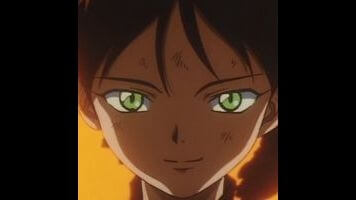For instance, take a look at the way “Asteroid Blues” starts. Before the show’s opening credits, there’s the black-and-white flashback prologue that will play multiple times over the course of the series. The first images we see in Cowboy Bebop are black-and-white images of a church shootout that recall John Woo’s The Killer. Events are diced up into fragmented, noir-ish images: A cigarette burns to ashes, a rose drops into a puddle, Spike Spiegel smiles, and bullets fly.
For this prologue to work, it has to be shown before the show’s first opening credits sequence. Confused first-time viewers should see the credits as a reaction to the prologue’s memory jumble. Spike’s drive toward a life of affected, languid, Zen-like movements is a reaction to the prologue’s self-explanatory fragments. The prologue, presented in black-and-white (and red) and scored by melancholic, slow piano jazz, is Spike’s past.
By contrast, the opening credits sequence, filmed with primary colors and scored with the bouncy and now iconic jazz number “Tank!,” is Spike’s prospective future. Characters zoom into focus in split-screen close-ups, drifting in and out of negative space. Scrolling text flashes across the screen. That text is the kind of authoritarian confinement that Spike and his partner Jet Black can’t live within the boundaries of. They are space cowboys, after all. To live an improvised life, like jazz, is their goal, but to achieve that dream of lawless bliss, Jet is forced to become the voice of bad news to Spike’s happy-go-lucky man of action.
In “Asteroid Blues,” we haven’t yet met Ed, Ein or Faye Valentine, so women, children and dogs are not a complicating factor just yet. Instead, we just have Spike and Jet on the trail of Asimov Solansen, a rogue syndicate drug dealer. Asimov peddles Bloody-Eye, a designer eyedrop-type drug that induces berserker rage and strength. He travels with a mysterious pregnant woman in tow. The pair’s very presence is a disturbance to the sluggish pace of life that characterizes the planet Tijuana they touch down on. In a non-descript bar, a bartender cleans glasses, patrons quarrel over a game of cards, and a cat sleeps as if it were in a coma (the only way you can tell that the cat is alive is that one of its ears twitches). Then the bar’s doors creak open, and a stranger stands in the entryway for a moment that feels like forever. Then he enters the bar with his pregnant lady friend.
Asimov, who is cursorily fashioned after Antonio Banderas’s character in Desperado (yes, I know he existed in El Mariachi before that, but the episode is a response to the way Banderas’s character looks in Desperado), is Spike’s opposite. That concept becomes apparent during the last fight in “Asteroid Blues,” particularly when Spike yells at Asimov that he’s spent too much time over-stimulating his senses in a vain attempt to get the jump on Spike (“You trust your eyes too much! You’re not a chameleon! You can’t see everywhere all at once!”). Asimov’s need for a jittery, drug-induced high puts him squarely 180 degrees opposite of Spike.
“Asteroid Blues” is, in many ways, a table-setting episode. It tells us several times and in a couple of different ways who Spike Spiegel is. Cowboy Bebop is all about Spike; Jet is just his foil and sidekick. Spike is perfectly characterized in the scene where, after being choked out by Asimov, he wakes up and is debriefed by Jet. We see the back of Spike’s head as Jet’s information washes over him. Spike leisurely stretches, taking his time, not showing any signs in his body language that he’s paying attention to Jet’s rap. Then Spike smiles as he shows Jet the vial of Bloody-Eye he took from Asimov. It’s the same chipper, self-satisfied smile he flashed to Asimov’s companion when he told her that he was a cowboy.
The last and certainly biggest remaining piece of the puzzle that is Spike’s identity in “Asteroid Blues” comes from Asimov’s woman. During Spike’s first encounter with the shaman (very mild spoilers: he’ll infrequently pop up throughout the series), he’s told that he “take(s) women too lightly.” As always, the shaman is right on the money. Since Cowboy Bebop’s world is Spike’s world, it is, as James Brown would have you believe, a man’s world. Note the scene where Asimov’s nameless lover lowers her ponderous cleavage onto the bar and the three lecherous gamblers in the corner all pause to ogle her while she takes a long drink. Her brief dalliance with Spike is a great first taste of the noirish assumption that runs throughout Cowboy Bebop: Namely, women are the downfall of men (i.e.: Spike). First impressions matter here, so if nothing else, remember that when you watch the gutting (sorry, couldn’t resist) finale of “Asteroid Blues.”
Hopefully see you next week, Space Cowboy.
Stray observations:
- We'll be covering one episode of this show per week. It only ran for 26 episodes and a movie, so that shouldn't take too long anyway.
- If you've never seen the series and want to follow along (and live in the United States), the entirety is posted on adult swim's video site.


 Keep scrolling for more great stories from A.V. Club.
Keep scrolling for more great stories from A.V. Club.